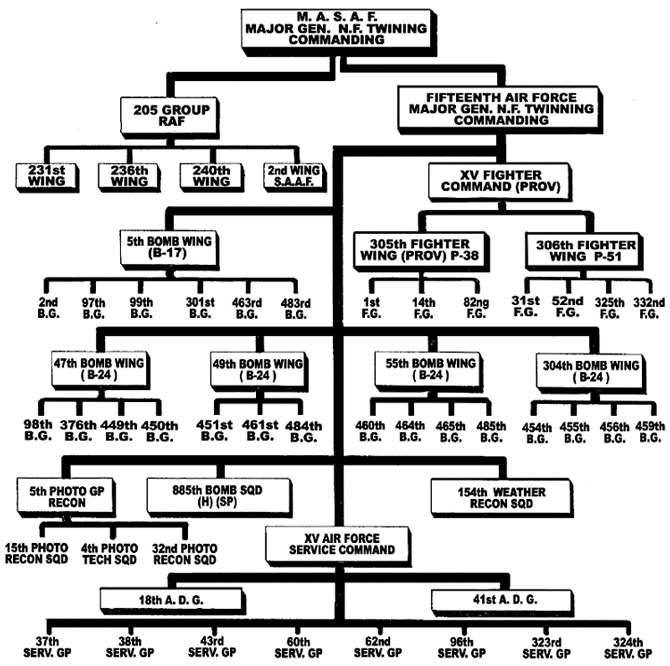| I've started this website to share
information about the Fifteenth Air Force and its involvement in
the successful end of World War II. If you find this site
useful, please consider donating to help with the cost of maintaining the
website by clicking on
GoFundMe. Contributions of information are also welcome. The intent is to provide a resource for those interested in learning about the organization and activities of the Fifteenth. To be successful, I need to hear from those individuals who have information I can include here. To contribute funds or information, contact Hughes Glantzberg. |
Commander
Major General Nathan F. Twining
Fifteenth Air Force was established on 1 November 1943 as part of the United States Army Air Forces in the World War II Mediterranean Theater of Operations as a strategic air force and commenced combat operations the day after it was formed. The first commander was General Jimmy Doolittle.
The Fifteenth Air Force drew its operational forces from heavy bombers of the IX Bomber Command, the strategic bomber command of the Ninth Air Force which was relocating to the United Kingdom to become a tactical air force in the European Theater of Operations, the Twelfth Air Force, and by a diversion of groups originally intended for the Eighth Air Force.
Mainly operating out of bases in southern Italy, the Fifteenth Air Force, along with the Eighth Air Force and RAF Bomber Command, became the instruments used by the Allies to carry the strategic air offensive to Axis occupied Europe and Germany.
The Fifteenth was de-activated in Italy 15 September 1945.
This film was donated by Guy Julien of Montpellier, France. Guy and his thirteen year old son, Maxime, put it together in honor of the Fifteenth Air Force.
To find something on the website quickly, try using the following Google SiteSearch facility...
Courtesy of the United States Holocaust Memorial Museum
Fifteenth Air Force Summary
In the 18 months of existence the Fifteenth Air Force, operating principally from the complex of airfields in southern Italy, destroyed all gasoline production within its range in southern Europe; knocked out all the major aircraft factories in its sphere; and destroyed 6,282 enemy aircraft in the air and on the ground.
The Fifteenth crippled the enemy's transportation system over half of once-occupied Europe with repeated fighter and bomber attacks. On occasion it helped disperse enemy counter attacks and spearheaded the advances of our own armies.
The Fifteenth dropped 303,842 tons of bombs on enemy targets in nine countries of Europe, including military installations in eight capital cities. Its combat personnel made 148,955 heavy bomber sorties and 87,732 fighter sorties against the enemy.
It lost 3,364 aircraft and 21,671 personnel killed, wounded, missing and taken prisoner -- 20,430 bomber crewmen and 1,187 fighter pilots.
The Fifteenth fought four broad campaigns: against enemy oil, enemy air force, enemy communications, and enemy ground forces. Most vital of the Fifteenth's oil targets was the Ploesti complex of refineries, which contributed about 30% of the entire Axis oil supply and an equal amount of gasoline. Ploesti was protected by 150 first class fighters and 250 heavy flak guns when the Fifteenth, with the cooperation of the RAF 205th Group of night bombers, began a series of attacks against it on April 5. The campaign continued until 19 August. Fifteenth and RAF bombers flew 5,287 sorties, dropping 12,870 tons of bombs. The cost was 237 heavies (15 of them RAF), 10 P-38 dive bombers and 39 escorting fighters. More than 2,200 American Airmen were lost. But results were good. At the end of the campaign the refineries were reduced to only 10% of their normal rate of activity and during the entire period from April to August the average production rate was reduced by 60%.
The Fifteenth followed up the Ploesti attacks by dropping 10,000 tons of bombs in attacks on three synthetic oil plants in Silesia and one in Poland, reducing their combined production by February of 1945 to 20% of what it was in June of 1944.
By devastating attacks on Weiner Neustadt and Regenshurg, two of the three main enemy fighter manufacturing complexes, the Fifteenth helped materially in the attainment of European air supremacy. By May 1944, estimated actual production stood at 250 aircraft a month within range of the Fifteenth against a contemplated production of 650 aircraft per month.
Through the counter-air force and oil campaigns, the Fifteenth was also attacking enemy communications and transportation systems far behind the front lines, disrupting supply movements from industrial centers over an 800 mile radius from the Italian airfields.
The Fifteenth also supplied Allied Army cooperation bombing targets at Salerno, Anzio, and Cassino in the Rome campaign. On 15 April 1945 the Fifteenth put up a record smashing 93% of its available aircraft to soften up the approaches to Bologna in one of the final missions of the Italian campaign.
A unique sidelight of the Fifteenth's operations has been the rescue and repatriation of air crews shot down in enemy territory. No other air force has undertaken escape operations in so many countries. The Fifteenth has returned 5,650 personnel by air, surface vessel and on foot through enemy lines. In more than 300 planned "reunion" operations, men have been brought back safely from Tunisia, Italy, France, Switzerland, Greece, Albania, Bulgaria, Rumania, Hungary, Yugoslavia, Austria and Germany.
Here's something few veterans and even fewer children and friends knew about the Fifteenth Air Force. Because winter presented a lot of bad weather causing missions to be cancelled, General Twining started "Lone Wolf" missions in order to keep the pressure on the Germans.
During the time the Fifteenth Air Force existed, many of the men of the air crews were captured by the Germans and placed in Prisoner Of War (POW) camps. At the end of the war, their stories told of the horrific treatment they received. Most of these stories were simply forgotten as best they could be and were never told or documented. The following is an exception. I believe this is one of the most accurate stories of what life was like in a POW camp.
The Fifteenth Air Force consisted of the following organizations:

Courtesy of Frank Ambrose


